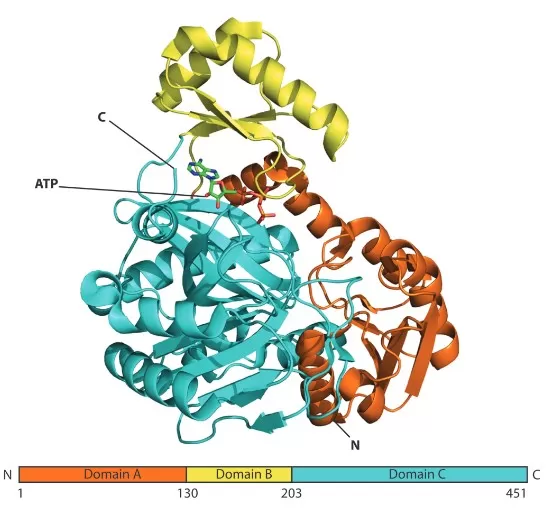Protein N-Terminus and C-Terminus: Structure, Functions, and Analytical Techniques
Proteins are key executors of biological activities, and their functions are closely related to their structures. The primary structure of a protein refers to the linear sequence of amino acids linked by peptide bonds, with the two ends of this chain termed the N-terminus (amino terminus) and C-terminus (carboxyl terminus). These termini are not merely structural landmarks but play critical roles in protein synthesis, localization, post-translational modifications, and functional regulation.
Starting and Ending Markers of Proteins
The N-terminus (amino terminus) is the end of the polypeptide chain bearing a free amino group (-NH₂) and serves as the initiation site during protein synthesis. Conversely, the C-terminus (carboxyl terminus) contains a free carboxyl group (-COOH) and marks the termination of polypeptide chain elongation.

protein structure
Chemical Properties of the N- and C-Termini
The N-terminus, with its hydrophilic amino group, is typically exposed on the protein surface. This hydrophilicity facilitates solubility and intracellular transport, while also enabling interactions with other molecules. Notably, many secretory and membrane proteins possess an N-terminal signal peptide that directs their translocation into the endoplasmic reticulum or plasma membrane, ensuring proper localization. The C-terminus, characterized by its acidic carboxyl group (-COOH), can release protons (H⁺) and form salts with bases. Additionally, the carboxyl group exhibits high chemical reactivity, participating in acylation reactions (e.g., esterification with alcohols or amidation with amines). Such modifications regulate protein stability and interactions, contributing to functional diversity.
Functional Roles of the N-Terminus
1. Localization and Trafficking:
The N-terminal signal peptide is essential for targeting proteins to specific organelles. For instance, insulin’s N-terminal signal peptide directs its entry into the endoplasmic reticulum for processing and folding.
2. Signal Transduction:
Certain transcription factors, such as NF-κB, utilize their N-terminal domains to bind DNA and regulate gene expression.
Functional Roles of the C-Terminus
1. Structural Folding and Stability:
The C-terminal sequence influences tertiary structure formation. For example, the C-terminal domain of lactate dehydrogenase stabilizes its active site, enhancing catalytic efficiency.
2. Post-Translational Modifications:
The C-terminus often undergoes modifications like ubiquitination, which tags proteins for degradation, or prenylation, which anchors proteins to membranes.
3. Molecular Interactions:
Many proteins, such as RNA polymerase II, utilize C-terminal regions to interact with DNA, RNA, or other proteins, forming functional complexes.
comparative analysis: N-Terminus vs. C-Terminus
|
Feature |
N-Terminus |
C-Terminus |
|
Chemical Group |
Free amino group (-NH₂) |
Free carboxyl group (-COOH) |
|
Synthesis Order |
Initiation site |
Termination site |
|
Modifications |
Acetylation, signal peptide cleavage |
Ubiquitination, prenylation, glycosylation |
|
Functional Roles |
Localization, signal transduction |
Folding, stability, degradation signals |
Analytical Methods for Terminal Identification
N-Terminus Detection:
- Edman Degradation: A classical method where phenylisothiocyanate (PITC) reacts with the N-terminal amino acid, generating a phenylthiohydantoin (PTH) derivative for sequential identification via HPLC or GC-MS. While precise, it is less efficient for large proteins.
- Mass Spectrometry: High-throughput analysis of enzymatically digested peptides, leveraging mass-to-charge ratio (m/z) to determine N-terminal sequences.
- Chemical Labeling: Amine-reactive tags (e.g., NHS esters) selectively label N-terminal residues for enhanced MS detection.
C-Terminus Detection:
- Carboxypeptidase Digestion: Enzymatic removal of C-terminal amino acids, followed by chromatographic or MS analysis.
- Chemical Cleavage: Specific reagents (e.g., hydrazine) target carboxyl groups for selective cleavage.
- Tandem Mass Spectrometry (MS/MS): Collision-induced dissociation (CID) fragments peptides, enabling C-terminal sequence reconstruction via fragment ion analysis.
Biological Significance and Applications
Understanding protein termini is pivotal for elucidating structure-function relationships. For example, mutations in the N-terminal signal peptide of cystic fibrosis transmembrane conductance regulator (CFTR) disrupt protein trafficking, leading to cystic fibrosis. Similarly, C-terminal truncations in tau protein are linked to neurodegenerative diseases like Alzheimer’s. In biotechnology, engineered termini are exploited for protein purification (e.g., polyhistidine tags) or therapeutic targeting (e.g., C-terminal fusion proteins in antibody-drug conjugates).
Conclusion: The "Life Code" of Protein Termini
The N- and C-termini are fundamental to protein architecture, dynamics, and functionality. Their study bridges basic science and practical applications, from drug design to diagnostics. Integrating advanced analytical techniques—such as cryo-EM for structural insights or CRISPR for functional genomics—will further unravel their roles in cellular processes.
References:
1. Mosca R, Schneider TR. RAPIDO: a web server for the alignment of protein structures in the presence of conformational changes. *Nucleic Acids Res*. 2008;36:W42-6.
2. Aebersold R, Mann M. Mass spectrometry-based proteomics. *Nature*. 2003;422(6928):198-207.


